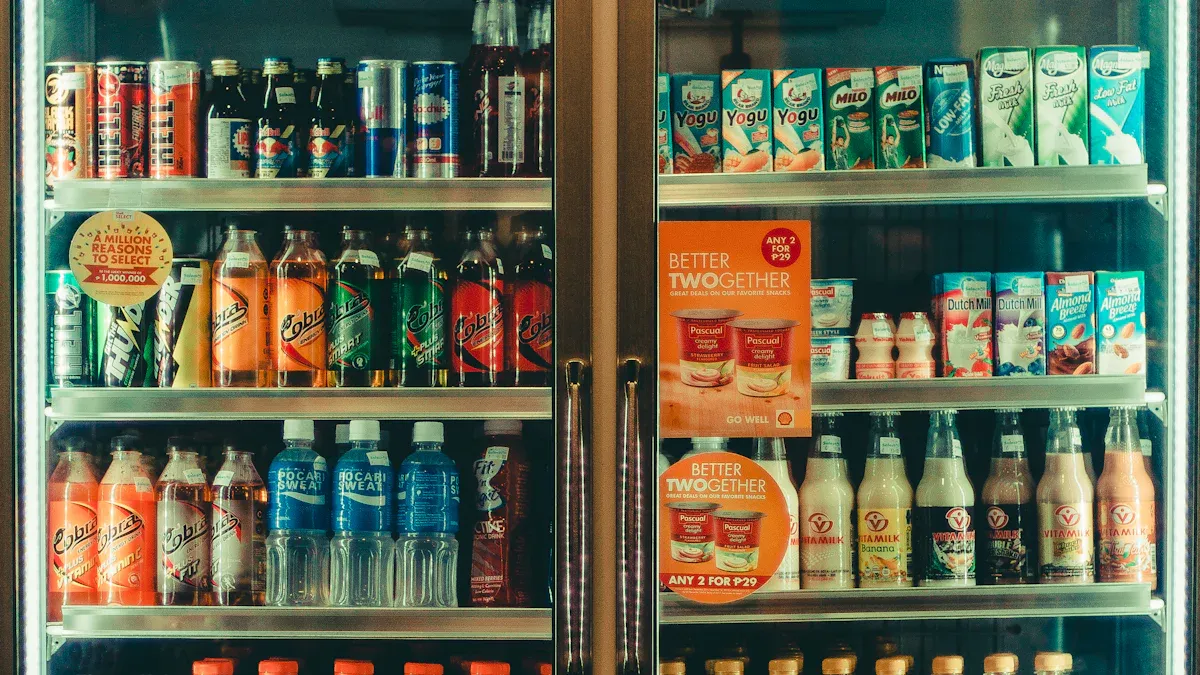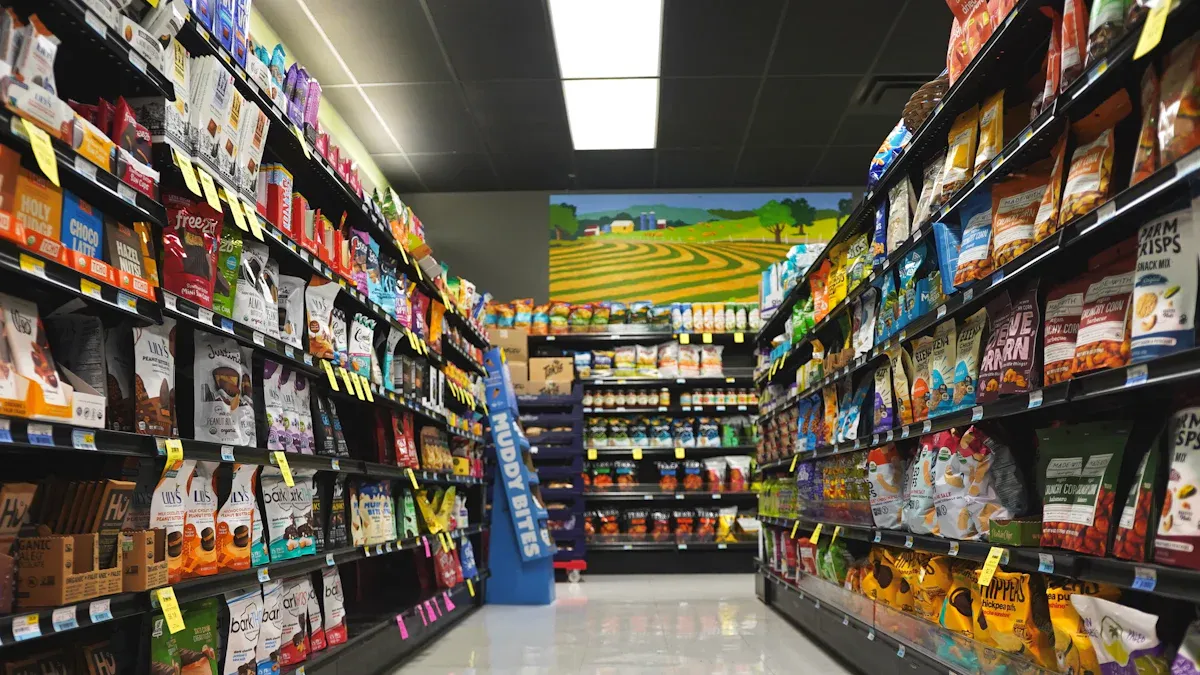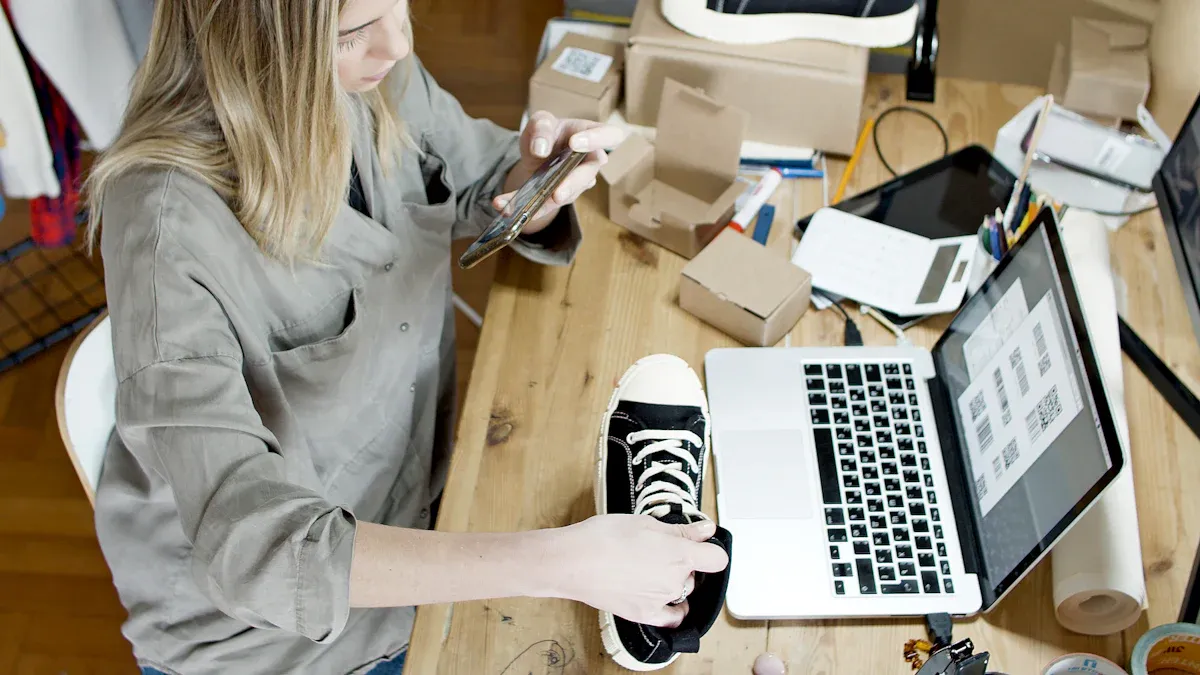
Eye-level shelf space stands as one of the most valuable assets in retail. Brands pay substantial slotting fees—sometimes reaching $150,000 for limited placements—to secure this prime shelf position. Research from Wal-Mart and Trax Retail shows that products on eye-level shelves achieve a 23% sales uplift and draw far more shopper attention than items on lower shelves. Retailers leverage shelf space to maximize visibility, while brands pay to boost product visibility and drive sales. In today’s Esl Retail environment, tools like Electronic Shelf Labels, ESL Gateway AP, and ESL Price Tag solutions help brands optimize shelf space and maintain visibility.
The Value of Eye-Level Shelf Space in Retail

How Shelf Space Influences Consumer Behavior
Visibility and Impulse Purchases
Retail shelf space at eye level plays a critical role in shaping consumer behavior. Products placed between 122 cm and 152 cm attract immediate attention because shoppers naturally scan shelves at this height first. Retailers in the retail industry often reserve this space for high-demand or high-margin products, knowing that increased visibility leads to higher chances of impulse purchases. Shoppers rarely bend to reach lower shelves, making those spaces less effective for maximizing sales. In large-format retail stores, eye-level displays near entry points further increase sales compared to standard shelving. Retailers use this strategic product placement to guide consumer attention and influence purchasing decisions.
- Eye-level shelf space increases product visibility and purchase likelihood.
- Products at eye level encourage impulse buying.
- Lower shelves require bending and are less visible.
- Retailers use eye-level placement to maximize sales.
Brand Recognition and Loyalty
Shelf space at eye level not only boosts visibility but also strengthens brand recognition. Shoppers often associate products at this level with popularity and quality. Brands with established market presence benefit more from premium shelf placement, as consumers recall familiar names more easily when they appear in their direct line of sight. Retailers in the retail industry leverage this effect by placing their own brands or best-sellers at eye level, reinforcing loyalty and driving repeat purchases. Product placement at this height helps brands build lasting relationships with consumers.
Sales Impact of Eye-Level Placement
Conversion Rates and Sales Uplift
Moving products to eye-level shelf space delivers measurable sales benefits. According to a report cited by Grocery Dive, products relocated to eye-level shelves in grocery or mass retail stores experience an average sales increase of about 6% over the long term. This uplift demonstrates the direct connection between shelf space and sales performance. Retailers seeking to maximize sales prioritize eye-level shelf space for items that drive revenue and market share.
Real-World Examples from Retail
Retailers have seen significant results by optimizing shelf space. For example, Spec’s Austin store increased sales by adding shelf-edge illumination at eye level, which enhanced product visibility and encouraged impulse purchases. The Nexgenus blog highlights the principle “eye-level is buy-level,” recommending that retailers reserve this space for high-margin or best-selling items. These real-world cases show that strategic product placement and shelf optimization can transform shopper behavior and improve profitability in the retail industry.
Psychological Drivers Behind Shelf Space Competition
Shopper Decision-Making at Eye Level
Consumers focus on products within their natural line of sight, making eye-level shelf space the most effective for attracting attention. Shoppers hold beliefs about shelf hierarchy: top shelves signal higher quality, middle shelves suggest popularity, and bottom shelves indicate lower price. Brands compete for eye-level shelf space to leverage these perceptions, aiming to maximize visibility and influence purchase decisions. Visual attention to shelf position interacts with brand memory, so established brands gain more from premium placement.
The Convenience Factor
Convenience shapes shopper choices in retail environments. Products at eye level are easier to see and reach, reducing effort and increasing the likelihood of purchase. Retailers use this knowledge to allocate shelf space efficiently, placing high-margin or popular products where shoppers can access them quickly. This approach not only improves the shopping experience but also supports maximizing sales and market performance.
Why Brands Pay for Shelf Space
The Role of Slotting Fees in Retail
What Are Slotting Fees?
Slotting fees represent payments that brands pay to retailers to secure valuable shelf space for their products. In the retail industry, these fees help retailers offset the risks and costs associated with introducing new products. The purpose of slotting fees extends beyond simple placement. Retailers use them to manage inventory, cover marketing expenses, and compensate for potential losses if a product fails to sell. These fees act as a screening mechanism, signaling to retailers that a manufacturer believes in the product’s market potential. Only brands expecting strong demand willingly pay large upfront slotting fees, which helps retailers decide which products to carry in a crowded market.
Note: Slotting fees can create barriers for small manufacturers, as the upfront costs often reach tens or even hundreds of thousands of dollars for regional or high-demand markets.
How Slotting Fees Are Calculated
Retailers calculate slotting fees based on several factors. The fee per item per store typically ranges from $250 to $1,000, but total costs can escalate quickly for brands seeking wide distribution. Retailers consider the product category, shelf space availability, expected sales volume, and the risk of unsold inventory. High-traffic locations and eye-level shelf positions command higher fees due to their impact on sales. Retailers also factor in the costs of stocking, marketing, and managing new products. The table below summarizes key aspects of slotting fees:
| Aspect | Explanation |
|---|---|
| Purpose of Slotting Fees | Payments from manufacturers to retailers to secure shelf space and compensate for risks. |
| Positive Impact | Incentivizes retailers to stock new products and manage inventory efficiently. |
| Negative Impact | Creates barriers for small brands and can lead to higher consumer prices. |
| Risk Factor | High upfront costs and risk of product failure, especially for smaller companies. |
| Market Effects | Both pro-competitive (new product introductions) and anti-competitive (barriers to entry). |
Financial Stakes and ROI for Brands
Cost-Benefit Analysis of Paying for Shelf Space
Brands pay slotting fees with the expectation of increased sales and greater market visibility. They evaluate the incremental sales generated by premium shelf space and compare their profit margins to those of the retailer. Manufacturers often gain more from incremental sales than retailers, which motivates them to engage in competitive bidding for shelf space. Brands assess the value of shelf space by analyzing the potential for higher product visibility, increased consumer demand, and improved distribution. They also consider the costs of compensating retailers and the impact of inter-retailer competition. Slotting contracts may take the form of per-unit time fees or wholesale price reductions, depending on the competitive landscape.
- Brands analyze incremental profit potential before committing to slotting fees.
- The growth in demand for promotional shelf space links directly to increased product variety and new product launches.
- Economic theory explains why brands pay retailers directly for shelf space, especially as the market value of shelf space has risen since the 1980s.
Risks of Unsold Inventory and Pay-to-Stay Fees
Paying slotting fees exposes brands to significant financial risks. If a product fails to meet sales expectations, the manufacturer absorbs the upfront costs and may face additional pay-to-stay fees to maintain shelf presence. The high failure rate for new products—up to 90% according to the FTC—means that many brands never recover their initial investment. Slotting fees can limit a manufacturer’s bargaining power, sometimes imposing extra terms that reduce profit margins. Brands must prepare strong data-driven pitches and demonstrate professionalism to limit fees and improve their chances of success. Negotiating slotting fees effectively becomes essential for managing these risks.
Competitive Strategies with Slotting
Blocking Competitors
Brands use slotting as a strategic tool to block competitors from securing prime shelf space. By paying higher slotting fees, a brand can occupy eye-level shelves, end-cap displays, or high-traffic areas, making it harder for rivals to gain visibility. Skilled brand representatives play a crucial role in negotiating and maintaining these positions. This approach not only increases a brand’s own sales but also limits the distribution opportunities for competing products.
- Brands negotiate for premium shelf space to maximize product visibility and customer flow.
- Building strong retailer relationships through joint initiatives and incentive programs encourages retailers to offer better shelf space.
Gaining Category Dominance
Securing and maintaining eye-level shelf space allows brands to dominate their product category in the retail market. Brands often present comprehensive marketing campaigns and leverage big data on sales, market share, and consumer demographics to prove their value to retailers. Long-term pitches, including exclusivity deals and retailer-specific products, help brands secure better shelf locations and maintain category leadership. For example, major brands like Kellogg’s invest in prominent displays and end-cap placements to stay visible despite competition from lower-priced alternatives.
Tip: Brands that support retailers with marketing strategies, resources, and communication often secure better shelf space and build lasting partnerships in the retail industry.
Slotting Fees: How Retailers and Brands Benefit
Retailer Advantages from Slotting Fees
Offsetting New Product Risks
Retailers face significant risks when introducing new products to their shelves. Slotting fees help offset these risks by providing financial compensation for unsold inventory and slow-moving items. Retailers use slotting to cover the costs of stocking, managing shelf space, and handling distribution. This system acts as insurance, reducing the impact of product failure and ensuring that retailers maintain profitability. Slotting fees also signal a manufacturer’s confidence in their product, which helps retailers prioritize items with strong market potential.
- Slotting fees mitigate financial risk for retailers.
- They cover costs related to shelf management and inventory.
- Retailers use slotting to insure against losses from unsold stock.
Generating Additional Revenue Streams
Slotting fees create new revenue streams for retailers beyond traditional product sales. These fees fund marketing initiatives, operational improvements, and better store layouts. Retailers optimize shelf space by prioritizing products that offer the highest potential for sales and profitability. Slotting fees also compensate for the opportunity cost of allocating shelf space to one product over another, allowing retailers to manage inventory efficiently.
- Slotting fees generate extra income for retailers.
- Retailers invest slotting revenue in marketing and store upgrades.
- Efficient shelf space allocation supports overall retail profitability.
Manufacturer Benefits of Paying Slotting Fees
Increased Product Visibility
Manufacturers benefit from slotting fees by securing premium shelf space in retail environments. Eye-level shelf placement increases visibility, making products more noticeable to shoppers. This enhanced visibility leads to higher sales and greater brand recognition. Manufacturers use slotting to stand out from competitors and encourage repeat purchases, building brand loyalty over time.
- Slotting fees secure prime shelf space for manufacturers.
- Increased visibility drives sales and brand growth.
- Shelf placement fosters consumer loyalty.
Enhanced Sales Opportunities
Slotting fees provide manufacturers with access to large retail networks and valuable shelf space. By paying slotting, manufacturers demonstrate commitment to their products, strengthening relationships with retailers. Retailers may actively promote products that generate slotting revenue, further boosting sales. Slotting also gives manufacturers a competitive edge, helping them outperform rivals in crowded retail categories.
- Slotting fees open doors to wider retail distribution.
- Manufacturers gain promotional support from retailers.
- Competitive shelf space placement increases sales opportunities.
Balancing Risks and Rewards in Retail Shelf Space
Managing Product Failure Risks
Both retailers and manufacturers must manage the risks associated with shelf space agreements. Brands face high upfront costs and complex compliance requirements, which can delay product launches and strain resources. Slotting fees represent a financial hurdle, especially for small brands, without guaranteed returns. Retailers risk carrying new or unproven products that may result in dead inventory and lost sales. They prefer established brands that offer predictable sales and financial incentives.
- Brands encounter high costs and compliance challenges.
- Retailers risk slow sales and unsold stock.
- Slotting fees balance risk between both parties.
Long-Term Shelf Presence
Securing long-term shelf space requires careful negotiation and strategic planning. Brands with strong sales velocity and proven performance can gain negotiating power, sometimes reducing or avoiding slotting fees. Retailers benefit from slotting by selecting products that maximize category sales and profitability. The system often favors large, established brands, which can limit innovation and diversity on retail shelves. Both parties must weigh the costs, risks, and rewards to achieve lasting shelf presence and sustained sales growth.
Tip: Brands should confirm slotting fees upfront, negotiate terms, and secure written agreements to protect their investment in shelf space.
Challenges Brands Face in Securing Shelf Space
Intense Competition for Limited Shelf Space
Big Brands vs. Small Brands in Retail
Brands compete fiercely for eye-level shelf space in retail environments. Large brands often dominate prime shelf positions due to established market presence, robust slotting fees budgets, and strong retailer relationships. They leverage extensive data and sophisticated slotting strategies to maintain visibility and maximize distribution. Small brands, in contrast, face significant costs and resource constraints. They must rely on agility and creativity to secure shelf space, often struggling against the scale and influence of larger competitors. Retailers now use consumer data and AI-driven insights to allocate shelf space, sometimes favoring niche or private label brands that align with emerging market trends and offer higher margins.
Retailers prioritize data-driven decisions, shifting shelf space allocation from traditional brand dominance to consumer-focused strategies.
Category and Store Constraints
Retailers must balance shelf space across multiple product categories, limiting opportunities for new brands to gain eye-level placement. Each store has unique layout constraints, and shelf space is finite. Established brands with proven sales volumes often receive priority, while startups face limited budgets for slotting fees and merchandising. The crowded retail environment makes it difficult for any brand to maintain optimal shelf positioning, especially when competitors invest heavily in slotting and in-store promotions.
| Challenge Category | Description |
|---|---|
| Limited Budget | Startups have smaller marketing and merchandising budgets, limiting investment in premium shelf space and displays. |
| Shelf Space Competition | Established brands dominate prime shelf areas due to retailer relationships and higher sales volumes. |
| Resource Constraints | Limited staff and resources to implement and maintain merchandising strategies across locations. |
| Retailer Relationships | New brands struggle to build strong retailer relationships needed for favorable shelf placement. |
Retailer Demands and Compliance
Merchandising Standards and Performance Metrics
Retailers impose strict compliance requirements on brands seeking premium shelf space. Brands must adhere to planogram standards, maintain a minimum number of facings, and ensure proper production grouping. Retailers monitor shelf compliance through regular audits, photo verification, and real-time data tracking. Store-level KPIs include facings, promotional display shares, and placement standards. Brands receive incentives such as bonuses for maintaining agreed shelf space and premium placements, but failure to comply can result in lost distribution and increased costs.
- Planogram compliance ensures consistent shelf layouts and maximizes product visibility.
- Proper compliance reduces out-of-stock situations and guides customers effectively.
- Optimized shelf arrangement places high-demand products in prime shelf space.
Navigating Store Layout Variations
Brands must adapt merchandising strategies to diverse store layouts and shelf configurations. Retailers expect consistent execution across all locations, which increases operational complexity and costs. Manual audits and limited real-time stock visibility hinder effective shelf management, making it challenging to maintain optimal shelf space and product availability. Brands lacking extensive market data struggle to optimize shelf placement and meet retailer expectations.
Financial and Operational Barriers
High Slotting Fees and Ongoing Costs
Securing eye-level shelf space in major retail chains requires significant financial investment. Brands must pay slotting fees, invest in in-store promotions, and provide sales incentives to retailers. These costs add up quickly, especially for startups with limited budgets. Brands also face ongoing costs for compliance, audits, and maintaining consistent shelf space across multiple locations. Competitors who negotiate better terms or invest more heavily in slotting can dominate prime shelf positions, creating additional barriers for others.
- Slotting fees and promotional costs strain brand budgets.
- Brands must align with retailer agreements and performance metrics to maintain shelf space.
- Insufficient investment capacity limits access to premium shelf space.
Seasonal and Promotional Shelf Changes
Retailers frequently adjust shelf space for seasonal promotions and new product launches. Brands must respond quickly to changing shelf layouts and slotting requirements, which increases operational demands and costs. Ensuring consistent product availability and timely restocking becomes critical, as visually appealing products lose customers if they are hard to find or frequently out of stock. Brands must experiment with merchandising strategies, but limited resources make adaptability challenging.
Consistent shelf presence and convenience remain essential for capturing consumer attention and building market share in retail.
Strategies for Brands to Secure Eye-Level Shelf Space
Negotiation Tactics with Retailers
Leveraging Sales Data and Market Insights
Brands approach retailers with robust sales data segmented by shelf position, store, and product category. They analyze how premium shelf positions, such as eye-level and endcaps, drive sales lift and shopper engagement. Eye-tracking studies reveal that products at eye level capture most shopper attention, with 65% of focus directed to middle shelves. Brands benchmark competitor product placement strategies and evaluate promotional effectiveness to measure return on investment. They collaborate with retailers to tailor shelf space negotiations, using consumer panel data to demonstrate alignment with retailer demographics. Recommendations based on these insights help brands optimize product placement and maximize sales.
- Brands collect and present sales data showing performance differences by shelf position.
- They use consumer behavior insights to justify requests for eye-level shelf space.
- Brands analyze competitor strategies and promotional effectiveness.
- Data-driven recommendations support optimizing product placement and promotional plans.
Offering Value-Added Services and Promotions
Brands strengthen their negotiation position by offering value-added services. They pay slotting fees to secure prime shelf locations and negotiate for lower slotting fees or increased facings to enhance visibility. Discounts on bulk orders incentivize retailers to provide better placement. Brands propose attractive promotions, such as buy one get one free or percentage discounts, which often lead to improved shelf positioning. In-store product demonstrations and samplings engage shoppers and convince retailers of product appeal. Offering exclusivity on new product variations makes the brand more appealing. Brands use AI-driven tools to measure customer engagement and conversion rates, providing real-time evidence to support requests for better shelf space. Building trust through reliable supply chains and attractive profit margins further strengthens their case.
- Brands pay slotting fees and negotiate terms to secure eye-level shelf space.
- Value-added services, promotions, and exclusivity deals enhance retailer appeal.
- Reliable supply chains and strong margins build trust and support long-term distribution.
Marketing and Merchandising Approaches
In-Store Promotions and Displays
Brands use strategic in-store promotions and displays to increase their presence at eye-level shelf space. They secure placement at or slightly below eye level to capture shoppers’ primary field of vision. Endcap displays at aisle ends attract attention and highlight featured or seasonal products, boosting exposure and sales. Cross-merchandising complementary products encourages add-on purchases and improves the shopping experience. Shelf-edge signage and product callouts guide shopper attention to promotions and product features, prompting purchase decisions. Brands invest in custom product displays to maximize the impact of prime retail space.
- Eye-level placement leverages natural shopper behavior for maximizing sales.
- Endcap displays and cross-merchandising boost brand exposure.
- Shelf-edge signage and callouts prompt purchases and reinforce product placement.
Packaging Innovations for Shelf Impact
Packaging plays a critical role in optimizing product placement. Brands employ eye-catching packaging to stand out and reinforce recognition. Visual disruption techniques, such as distinctive colors and vertical brand blocking, attract more shopper attention. Brands adjust product facings to ensure visibility without clutter. Interactive digital displays in high-traffic areas engage customers and enhance visibility. Staff training supports interactive displays and improves the shopper experience. Brands analyze shopper data and heat maps to prioritize high-performing products in prominent locations, continuously adapting strategies based on trends and customer behavior.
- Packaging innovations help brands optimize product placement and drive sales.
- Vertical merchandising and visual disruption increase attention and conversion rates.
- Data analysis guides ongoing adjustments for maximizing sales.
Building Strong Retail Partnerships
Long-Term Agreements and Joint Initiatives
Long-term retail partnerships build trust and mutual value. Brands demonstrate commitment through consistent supply, quality, and marketing support, which retailers reward with prime shelf placement. Collaboration on promotions, in-store activations, and co-branded campaigns increases shopper engagement and sales, justifying premium shelf space. Brands showing strong consumer demand and marketing support are more likely to secure and maintain eye-level shelf space. Sustained partnerships position brands as valued partners, leading to long-term shelf placement stability and growth opportunities.
- Consistent supply and marketing support earn brands premium shelf space.
- Joint initiatives and co-branded campaigns increase engagement and sales.
- Long-term agreements foster stability and growth in shelf placement.
Exclusive Product Launches
Brands offer exclusive product launches to retailers as part of their slotting strategy. These launches provide retailers with unique offerings, attracting shoppers and differentiating the store from competitors. Exclusive products often receive priority in product placement, including eye-level shelves and endcaps. Brands support these launches with customized sales and marketing materials, sampling events, and staff training. Guaranteeing consistency in supply chain and product quality builds retailer trust and leads to long-term shelf placement stability.
Tip: Brands that invest in exclusive launches and joint initiatives with retailers often secure better shelf space and strengthen their distribution network.
Technology and Data in Shelf Space Optimization

Shelf Optimization Tools in Retail
Planogram Software and Automation
Retailers rely on advanced planogram software to manage shelf layouts and ensure compliance with merchandising standards. These tools automate the process of slotting, allowing retailers to allocate shelf space based on real-time sales and inventory data. AI-powered analytics platforms, such as ParallelDots’ ShelfWatch, use computer vision to monitor stock levels, verify planogram compliance, and assess the effectiveness of promotional displays. By integrating these technologies, retailers can optimize product placement, reduce stockouts, and maximize sales. Automated image analysis supports continuous monitoring, ensuring that products remain in their designated slots and that slotting fees deliver value.
Real-Time Shelf Performance Tracking
Real-time shelf performance tracking has transformed how retailers approach slotting and product placement. Retail analytics tools collect data on sales, inventory turnover, and shopper behavior. This information helps identify high-performing products and allocate prime shelf space accordingly. Continuous monitoring allows for quick adjustments to shelf layouts, supporting strategies for optimizing product placement. Retailers use these insights to refine slotting agreements and ensure that slotting fees correspond to actual sales performance. The result is increased sales, reduced lost revenue from stockouts, and improved customer satisfaction.
Data-Driven Slotting Decisions
Predictive Analytics for Shelf Placement
Predictive analytics play a crucial role in slotting decisions. Retailers analyze historical sales data, inventory trends, and customer movement patterns to forecast demand and determine optimal shelf locations. Planogram software, combined with sales analytics, enables retailers to test different product placement strategies through A/B testing and heatmaps. These tools help retailers identify high-traffic zones and adjust slotting to maximize the impact of slotting fees. By prioritizing high-margin products for eye-level shelves, retailers can boost sales and improve the return on investment for both themselves and manufacturers.
Shopper Insights and Behavior Analysis
Understanding shopper behavior is essential for optimizing product placement and slotting strategies. Retailers gather observational, activity, and sales data to track the effectiveness of product placement. Computer vision technology provides real-time insights into SKU-level performance, supporting data-driven arguments for premium shelf space. Retailers also consider factors such as seasonality, regional preferences, and customer demographics when making slotting decisions. By analyzing shopper patterns, retailers can refine slotting agreements and ensure that slotting fees reflect the true value of eye-level shelf space.
Future Trends in Retail Shelf Space Management
AI and Machine Learning Applications
AI and machine learning are reshaping the future of slotting and shelf space management. Video recognition technology, powered by advanced cameras, monitors shelves in real time, identifies products, and tracks stock levels. Robots and RFID-enabled smart shelves automate inventory management, alerting staff when restocking is needed. Retailers like Amazon and Walmart have adopted these technologies to enhance inventory accuracy and speed up replenishment. AI-driven slotting systems enable personalized store layouts and dynamic product placement, ensuring that slotting fees align with actual sales impact.
Omnichannel Shelf Space Strategies
Retailers increasingly adopt omnichannel strategies to integrate physical and digital shelf space. Automated checkout systems, such as Amazon Go, streamline the purchase process and reduce labor costs. Smart home devices, like AI-powered refrigerators, connect with retail automation to track inventory and generate shopping lists. Retailers use data from both online and offline channels to inform slotting and product placement decisions. As retail spaces become more automated and efficient, slotting fees and slotting strategies will continue to evolve, supporting seamless customer experiences across all touchpoints.
Eye-level shelf space remains a high-stakes asset in retail, driving sales and brand growth. Brands invest in slotting fees and strategic merchandising to secure these prime positions. The competition for shelf space is intense, but successful placement yields significant rewards.
Tip: Brands and retailers should use data-driven planograms, foster strong partnerships, and innovate in visual merchandising to maximize shelf impact.
Key strategies for success:
- Position high-margin products at eye level to boost visibility and sales.
- Differentiate packaging and maintain neat, well-stocked displays.
- Continuously refine placement using shopper insights and advanced analytics.
Effective shelf space management benefits both retailers and brands, supporting long-term profitability and customer satisfaction.
FAQ
What is eye-level shelf space in retail?
Eye-level shelf space refers to the area on store shelves positioned between 48 and 60 inches from the floor. Products placed here attract the most shopper attention and typically achieve higher sales.
Why do brands pay slotting fees?
Brands pay slotting fees to secure premium shelf positions, especially at eye level. These fees help retailers offset risks and costs associated with stocking new products and managing inventory.
How do retailers decide which products get eye-level placement?
Retailers use sales data, product performance, and slotting fee offers to determine shelf placement. They prioritize high-margin, popular, or exclusive products for eye-level shelves to maximize sales and profitability.
Do slotting fees guarantee long-term shelf space?
Slotting fees usually secure shelf space for a limited period. Brands must meet sales targets and compliance standards to maintain their position. Retailers may reallocate space based on ongoing performance.
Can small brands compete for eye-level shelf space?
Small brands face challenges due to high slotting fees and limited budgets. Some succeed by offering unique products, building strong retailer relationships, or targeting niche markets.
What technologies help optimize shelf space?
Retailers use planogram software, real-time analytics, and AI-powered tools to monitor shelf compliance and sales. These technologies support data-driven decisions for product placement and inventory management.
How does shelf placement affect consumer behavior?
Products at eye level are easier to see and reach. Shoppers often choose these items first, leading to more impulse purchases and higher brand recognition.
Are slotting fees legal and regulated?
Slotting fees remain legal in most regions, but some countries or states have regulations to ensure fair competition. Retailers and brands must follow local laws and industry guidelines.


